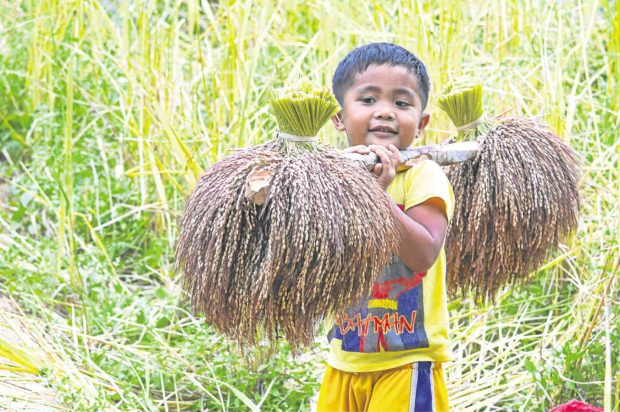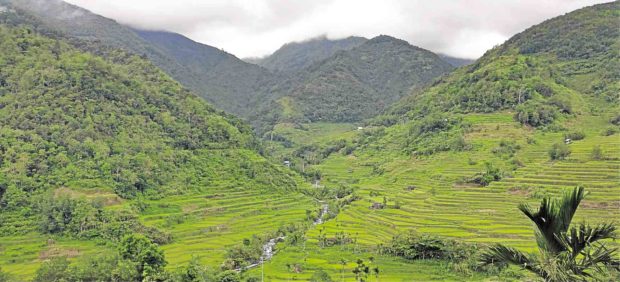Cordillera rice terraces to get P4-B rehab fund

YOUNG FARMER Children in Ifugao villages, like 7-year-old Julio Abbuy of Hingyon town, learn the basics of heirloom rice cultivation early. —KARLSTON LAPNITEN
BANAUE, Ifugao — The rice terraces of Ifugao have been hailed as examples of indigenous engineering ingenuity, with small forests at the top of mountains delivering water down to rice paddies shaped like staircases to capture water and maintain soil minerals.
But what sustains these architectural wonders are the rice ritual cycles, which are equal parts pest management and soil conservation techniques, because traditional rites follow the peculiar behavior of the seasons as well as insects and animals that thrive nearby.
Preserving and practicing indigenous knowledge have become the core ideas behind a five-year, P4.125-billion plan to conserve and rehabilitate many of the rice terraces in the Cordillera.
Food security
The development plan requires every agency, group and people involved in rice terraces conservation to unite and revitalize the centuries-old rice cultures of the Benguet towns of Kibungan, Kapangan and Kabayan; the Ifugao towns of Asipulo, Banaue, Hingyon, Hungduan, Kiangan, Mayoyao and Tinoc; the Mountain Province towns of Barlig, Bauko, Besao, Bontoc, Sabangan, Sadanga, Sagada and Tadian; and the Kalinga towns of Balbalan, Lubuagan, Pasil, Tanudan, Tinglayan and Pinukpuk.
Article continues after this advertisementThe latest initiative to sustain Cordillera rice terraces was developed by the National Anti-Poverty Commission (NAPC) in September last year, intending to tap indigenous knowledge systems and practices to achieve food security for upland communities by 2030, said Sem Cordial, director of the NAPC policy and planning service.
Article continues after this advertisementThe new plan was presented to local governments, agencies and scholars at a conference here on Nov. 21.
The five-year plan seeks the creation of a Cordillera terraces office to oversee the development plan. In 2008, the late Sen. Edgardo Angara filed a bill seeking to create the Cordillera Terraces Authority, which would formulate a 10-year Cordillera terraces master plan. It has been marked pending at the committee level since 2010.
The draft plan said it could increase rice production in the Cordillera by 10 percent and reduce production cost by 10 percent in 2023.
Because rice farming is heavily dependent on irrigation, the plan also aims to increase the region’s forest cover by 10 percent.
High production cost
Aggravated by surging inflation, the high cost of production and maintenance remains the top problem that plagues terrace farming, according to Leah Enkiwe-Abayao, director of the Cordillera Studies Center at the University of the Philippines in Baguio.
These issues continue to discourage farmers from maintaining their family terraces, she said, leading some to abandon rice farming for better yielding cash crops or leave farming altogether for other jobs.
Still unresolved is the lingering generational crisis involving younger Cordillerans who lack interest in retaining their family terraces, she said.

HERITAGE SITE The rice terraces of Hapao in Hungduan town, Ifugao province, have been included in the list of Unesco’s World Heritage Sites. These paddies, where heirloom rice is grown, have sustained generations of Ifugaos. —REM ZAMORA
In Sagada, Jaime “Ama Tigan-o” Dugao, an elder, said the young preferred to be tour guides because rewards were immediate.
Climate change may also be the culprit for reduced water supply despite the increase of forest covers, he said.
In Ifugao, climate change has disturbed the traditional rice cycle, which could have spoiled or nullified certain rituals, according to Roscoe Kalaw, provincial tourism officer.
Farmers, however, fear the conservation plan would be undermined by the administration’s “Build, Build, Build” infrastructure program. “Conservation is not among [the] government’s impact projects as it does not actually promote building large or more infrastructure,” said Nestor Peralta, a farmer from Tinoc town.
Loans
Kalaw shared the same observation, saying no administration has tried taking out huge loans from international banks to fund conservation efforts.
He said the preservation plan needed to learn from the Ifugao experience as conservation efforts were “easy to discuss but are in reality hard to address.”